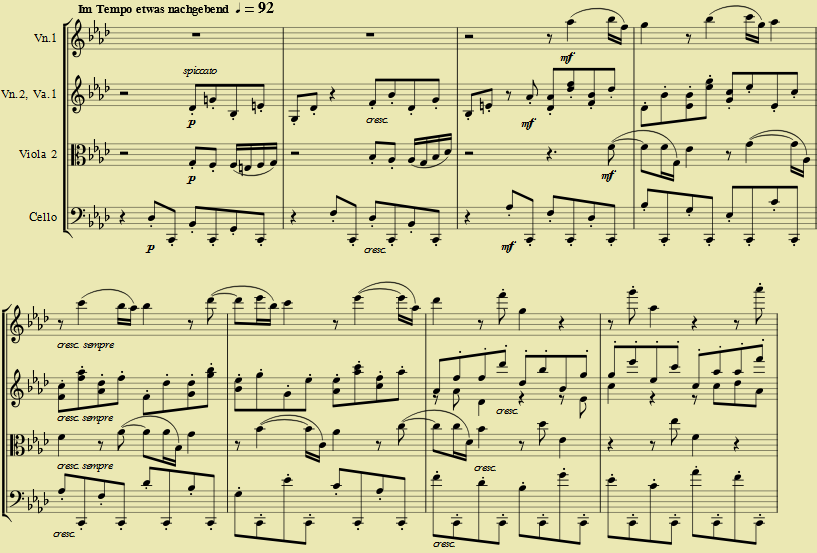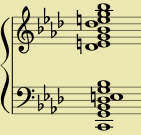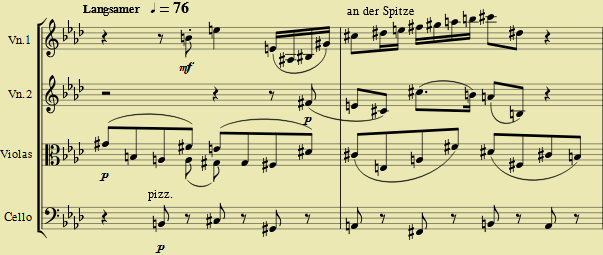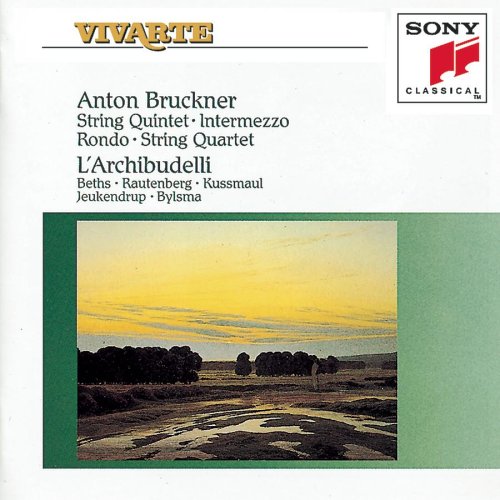
Bruckner: String Quintet, String Quartet et al
L'Archibudelli
Sony, recorded 1994
Buy at Amazon.com
___________
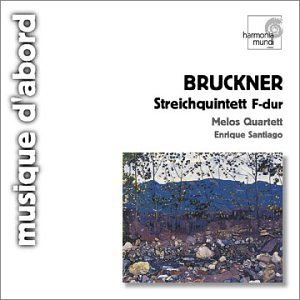
Bruckner: String Quintet
Melos Quartet with Enrique Santiago
Harmonia Mundi, recorded 1992
Buy at Amazon.com
___________
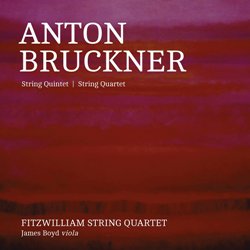
Bruckner: String Quintet
Fitzwilliam String Quartet with James Boyd
Linn, recorded 2011
Buy at Amazon.com
Like any string quintet, Bruckner's F major offering struggles to gain traction with audiences and musicians distracted by the far vaster repertory and ensemble roster for string quartets. If that weren't enough, string players specifically grumble about Bruckner's awkward melodic lines and his insistence on highlighting uncomfortable flat keys. Despite that, his Quintet is blessed with several fine recorded performances. My favorite comes from L'Archibudelli, a period instrument outfit whose name derives from the Italian for "gut strings". They indeed eschew the metal strings that started to predominate in the late 1800s, and like most ensembles focusing on historically informed performance, they avoid the habitual thick vibrato that became standard on bowed string instruments during the Fritz Kreisler era, but instead reserving that technique for slow or lyrical passages. What comes through most vividly in their 1994 Sony recording is a raw enthusiasm for this music. And the slower attack time and rich harmonic spectrum of the gut strings (contrasted with the more responsive envelope and brilliant timbre of their modern steel-core counterparts) seems especially well suited to Bruckner's sound world. Indeed L'Archibudelli's version of the Quintet sounds the most "symphonic" of any I've heard. It's interesting to compare it with more conventional modern interpretations, such as that by the Melos Quartet (with 2nd violist Enrique Santiago) which dates from about the same time. The Melos rendition is solid and intelligent, and avoids dragging during the distended Adagio movement. In between these two approaches is the 2011 recording by the Fitzwilliam String Quartet (plus violist James Boyd), a group that usually employs modern instruments but which turned to hand-wound gut strings for this recording. Like L'Archibudelli, the Fitzwilliams reflect the current (and welcome) trend toward more modest use of vibrato. They take the fast movements more broadly than the others, making up for this with a brisker pace in the Adagio. And true to their vision of late 19th century Viennese performance standards, they add the occasional bit of rubato and portamento to their interpretation, which should appeal to listeners who want to savor each note.
Most of the Quintet legitimately "sounds" like the Bruckner we all know from his orchestral and choral works. Organist as he was, he mainly conceived of sonic mass through the projection of individual lines, and he conspicuously avoids multiple stops in his Quintet (the work is almost devoid of triple/quadruple stops, and even double stops are infrequent). Instead he conveys his characteristic sense of sonority through careful use of register and instrumental spacing. All three of these recordings successfully communicate this sense of breadth that's so essential to any Bruckner experience.
The Quintet's first movement is in 3/4 time — a novelty for Bruckner. None of his symphonic first movements start in this time signature, though the one that perhaps comes closest (No. 6, whose first movement is in written in 4/4 but features frequent eighth- and quarter-note triplets) is contemporaneous with the Quintet. In lieu of a stereotypical tremolo-based opening, Bruckner launches the Quintet with an immediate statement of the main theme in the 1st violin, accompanied by the other instruments at the bottom of their range. Brucknerian chromaticism is soon apparent: we're supposed to be in F major, but as early as the first measure we encounter A♭ and D♭, and by end of the seventh bar we've already cycled through all twelve pitch classes. This melody reminds me of the opening theme of the Sixth Symphony, which is in A major but with flattened second, sixth and seventh scale degrees:
An interesting stroke in this otherwise fairly standard sonata-allegro movement comes at the crux of the development section. In lieu of a loud climax, Bruckner reduces the texture to monophony, a single unaccompanied instrument playing eighth notes derived from the third and fourth measure of the main theme, which in turn leads into the recapitulation at a pp dynamic level.
Next up is the quirky D minor scherzo:
Originally in third place, it was apparently too difficult for the intended premiering musicians, so Bruckner contributed a substitute Intermezzo (also in D minor). I'm not sure what was so challenging about the Quintet's original scherzo (it seems no tougher to me than the finale, for example), but the Intermezzo appears as the fifth track on all three of these albums, so you can compare for yourself. Both alternatives use the same Trio, which is a rhythmic and melodic relative of the Trio in the Fifth Symphony.
The obligatory Bruckner adagio follows:
It's perhaps the most troublesome movement of the four. In his symphonies, Bruckner could propel his slow movements forward using a variety of orchestral/timbral effects and — in the late symphonies especially — extreme chromaticism. But here, with a monochromatic ensemble and relatively diatonic harmonies, the broad tempo is harder to sustain. One example is the repeated notes in the accompaniment of the second theme (itself basically an inversion of the first theme) which recalls a similar effect in the slow movement of the Third Symphony, but in the present case sounds diluted without the chorus effect of an orchestral string section:

L'Archibudelli's propensity for audible "group breathing" is occasionally audible here, but not distractingly so, at least to my ears. Their tempo is the most lugubrious, a minute longer than both the Fitzwilliam and Melos ensembles. A highlight of the latter's performance is the ppp G♭ pedal in the cello that ends the movement: seamless and exquisite in their rendering.
Robert Simpson dissed the Quintet's finale as "not fully satisfactory as a piece of composition", but I think it's the most interesting of the movements, and I admire its formal originality. After the third movement's G♭ major coda, we start out with a D♭ pedal in the 2nd viola, beneath some spiccato figuration that reinforces D♭ as the dominant of G♭. The closest thing to a melody here is a simple syncopated stepwise figure in the 1st violin starting in bar 5:

After 16 bars, though, instead of resolving to G♭, there's a short rest, followed by a sudden change of tempo, tonality and mood. The cello enters with a pedal on low C, the 2nd violin and 1st viola resume more sinister spiccato arpeggios, and the 1st violin and 2nd viola exchange a brief turn motif that lasts three beats, though the time signature remains 4/4.
The music builds and subsides on a E diminished 7th chord over that C pedal (consistent with F minor)...
...then peters out in a combination of low spiccatos and pizzicatos.
Having thus transitioned harmonically from the dominant of G♭ to the dominant of F minor using musical material that feels introductory, Bruckner takes another pause and launches into what would appear to be the main theme. Except that the key is E major, not F. This is the clue that what we're hearing is really the well-disguised second theme group. Indeed this is one of the great contrapuntal second themes so often found in Bruckner finales. Like the corresponding theme group in the finale of the Third Symphony, it has the rhythmic feel of a polka:
The 1st viola's eighth notes are reminiscent of the second theme in the Second Symphony's finale, with its leaps of a sixth, and it's this line that gets most of the developmental attention later on, even though the main voice in this gesangsperiode is the soaring cantilena in the 1st violin. Getting the balance right here is a challenge due to the complex counterpoint and Bruckner's predilection for moving the primary melodic focus among the instruments. Of the three recordings, here I prefer the engineered emphasis on the bass that enhances the cello pizzicatos in the Melos rendition.
Bruckner meanders through a few keys before restating the tune in E major. The continuation of the second theme group features a raw-edged cello melody in quarter notes, basically an augmentation and inversion of the aforementioned 1st viola line, with triplets above it:
Gradually the other four instruments get their own fugue-style entrance with the cello theme, each one in a different key (unlike a classical fugue). This closing theme leads directly into the development, which mainly concerns itself with the cello theme and its accompanying triplets, along with the earlier 1st viola line in its "pure" form with the sixth leaps. All these elements are freely inverted and recombined in the familiar Bruckner manner. In some of the softer passages, the Melos musicians choose to play without vibrato to contrast with the more lyrical expositions that came earlier.
At about the 6½ minute mark, the 1st violin plays a slow reminiscence of its countermelody from bar 5:
Then the triplets that accompany it peter out the way the first theme group did in the exposition. The second theme group follows, but in the "wrong" key of D♭ major. This section otherwise gets a fairly literal repetition, but instead of the cello continuation, there's a codetta, another pause, and then a proper recapitulation of the first theme group, with the pedal transferred from second viola to cello and transposed from D♭ to C. Note how this harmonic motion represents a prolongation of the movement's initial D♭ to C bass movement.
After 14 bars, the tempo slackens and the C pedal resolves (finally) to F. The 1st violin restates its countermelody from bar 5, but inverted and elongated:
The middle strings pick up this idea, while the lower two instruments turn to F tremolos underpinning the F major arpeggios in the 1st violin that bring the work to a close. Until this 29 bar coda, there has been no conventional recapitulation in the tonic, nor any restatement of the closing theme in any key, nor any particular establishment of F major as a tonality elsewhere in the movement. The finale isn't so much in sonata form as it is in a kind of arch form similar to that found in Brahms' Tragic Overture or the last movement of Sibelius' Fourth Symphony, and its tonal design only makes sense in the context of the entire four-movement work.
A nice bonus in the L'Archibudelli and Fitzwilliam albums is the inclusion of the C minor string quartet that dates from Bruckner's apprentice years. L'Archibudelli additionally offers his standalone Rondo in C minor, thus completing the collection of Bruckner's surviving chamber music for strings. These early works don't yet have the recognizable Bruckner sound, but they do offer traces of the genius that would eventually burst out. Nevertheless, any of these three albums is excellent enough to please those interested in exploring the underappreciated gem that is the Bruckner String Quintet.
- First published February 2014, revised February 2017
![]()
Selected writings |
Schellsburg home
Jerry Hunt |
cribbage
![]()
Original Material and HTML Coding Copyright © 2014–2017 by
Michael Schell. All Rights Reserved.



